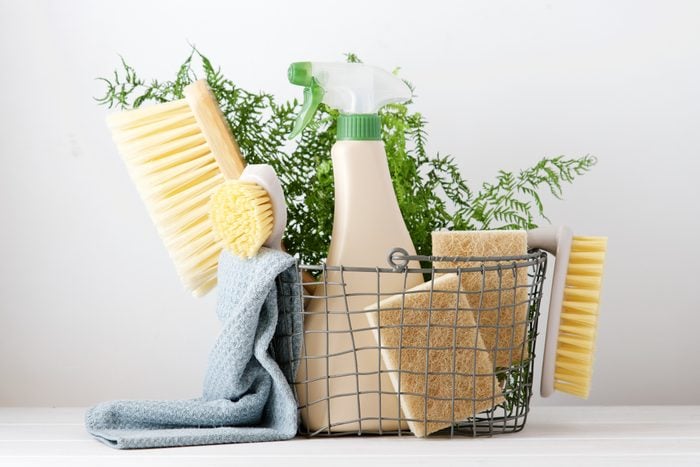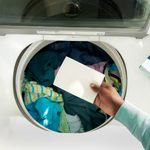What Is Green Cleaning?

Some chemicals in our cleaning products contribute to health problems and harm nature. Here's what to know about the benefits of going green.
Our editors and experts handpick every product we feature. We may earn a commission from your purchases.
I used to love the smell of my clothes, fresh out of the dryer, fluffed and perfumed by conventional laundry products. I thought those aromas were what “clean” smelled like.
Turns out it was just a thought some marketing experts put in my head. Now that I know how harmful some of those synthetic chemical ingredients are to my family and the natural world, I can hardly stand the smell.
Luckily, those products were easy to replace with healthier ones. And after going green, my clothes, kitchen and floors are as clean as ever.
“Taking the toxins out of cleaning products can help with all different types of health issues, from breathing difficulties all the way to cancer,” says Leslie Reichert, a podcaster and author of The Joy of Green Cleaning. “And usually if a product is safe for an individual, it’s safe for the environment, too.”
On This Page
What Is Green Cleaning?
Green or eco-friendly cleaning means using products and practices that are minimally harmful to people, pets and the environment, including the person doing the cleaning. Green cleaning involves:
- Products that don’t contain harmful chemicals;
- Methods like spraying products directly onto a microfiber cloth instead of onto surfaces or in the air, to reduce the risk of inhaling chemicals;
- Using the appropriate amount of product for the purpose, avoiding waste and unnecessary chemical exposure;
- Storing chemicals safely.
However, because terms like “green,” “eco-friendly,” and “all-natural” are unregulated and often misleading, it can be tricky to figure out which cleaning products are actually safe.
“Cleaning with safe products can make a huge difference for kids, pets and the entire family,” says Reichert. “But you really need to do your homework and learn what’s in the products you are purchasing.”
Why Is Green Cleaning Important?
Green cleaning is important to your health and that of the natural world.
“It’s a simple choice to protect yourself and your loved ones,” says Taryn Tuss, vice president of marketing and communications at Green Seal.
“Conventional cleaning products can contain some nasty chemicals that cause serious health effects. In fact, one scientific study found that regular, long-term use of cleaning sprays caused a decline in lung function equivalent to smoking 20 cigarettes per day.”
Some conventional cleaners also contain chemicals like phthalates and bisphenol A (BPA). These disrupt the endocrine system and are linked to hormone changes, birth defects, obesity, diabetes, thyroid irregularities and reduced immune function. Others can cause breathing problems, asthma, headaches and allergic reactions.
What’s Wrong With Conventional Cleaning Products?
While health problems caused by BPAs are becoming more widely known, many other products contain thousands of chemicals that haven’t been tested by manufacturers or the Environmental Protection Agency (EPA).
“And because cleaning product formulations are considered proprietary, companies aren’t required to disclose individual ingredients,” says Tonya Harris, an environmental toxicity specialist and author of The Slightly Greener Method. “So it’s a guessing game many times when it comes to knowing what’s in our cleaning products.”
What Is the Difference Between ‘Green’ and ‘Eco-Friendly’?
Sometimes green refers more to human health, like the use of natural ingredients. Eco-friendly denotes it’s less harmful to the environment, Harris says, because it incorporates sustainable packaging materials or manufacturing practices that reduce greenhouse gasses. But since neither term is regulated, it pays to read labels and do your research.
What Are the Best Products for Cleaning Green?
First, see if a reputable third-party eco-label like Green Seal or Environmental Working Group (EWG) certifies the product. Also, check the company’s website to see if it substantiates green claims with scientific evidence. And consider DIY.
“I’m a huge fan of making your own cleaning products,” says Reichert. “They work great and are made out of items in your pantry. If you clean with things you can eat, I think it’s pretty safe!”
Once you’ve chosen products, spray them into a microfiber towel before wiping surfaces, minimizing the amount of airborne chemicals. Also, resist the urge to over-clean.
“Cleaning regularly is enough to prevent the spread of germs, without turning to disinfectants,” says Tuss. “Disinfectants contain harsh chemicals, so save your disinfecting products for when somebody sick has been in your house.” For a deeper dive into safe disinfectants, Green Seal offers this guidance.
To make the switch to green products easier, prioritize the product you use most frequently and replace the rest as they run out.
Best green cleaning all-purpose cleaner
A solution of vinegar and water, or Castile soap, can make for a versatile and safe cleaner. For something you can purchase, Harris likes Vermont Soap Organics Liquid Sunshine Spray and Wipe.
“This cleaner is made from saponified organic coconut, olive and jojoba oils, along with essential oils,” she says. “It has a great scent and is great for regular everyday cleaning, as well as cutting through grime.”
Best green cleaning floor cleaner
“If you have pets or small children, a floor cleaner should also be one of the first to be replaced,” says Harris. Small children and pets are especially susceptible to toxins because they’re often on the floor, putting toys in their mouths, and licking fingers and paws. Same with your dog who drinks out of the toilet.
Again, Castile soap or vinegar and water works well. Or try Dr. Bronner’s Sal Suds.
Best green cleaning laundry soap
Reichert also recommends focusing on the laundry, because clothing and bedsheets always touch our skin. “Most people use too many chemicals in their laundry,” she says. “Between the detergent that stays in your clothes for days, as well as the softener and dryer sheets, the laundry room is full of toxins.”
Harris recommends Molly’s Suds laundry detergent, which contains sodium carbonate, sodium bicarbonate and sea salt. “It’s gotten so many tough stains out in our family of FIVE!,” says Harris.



